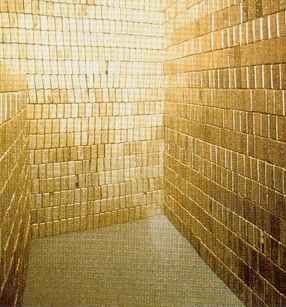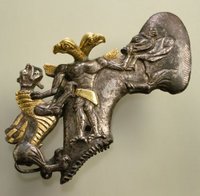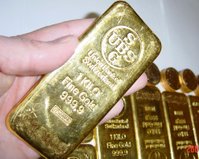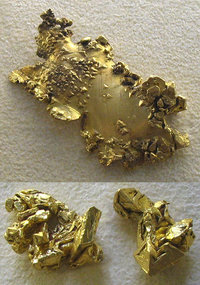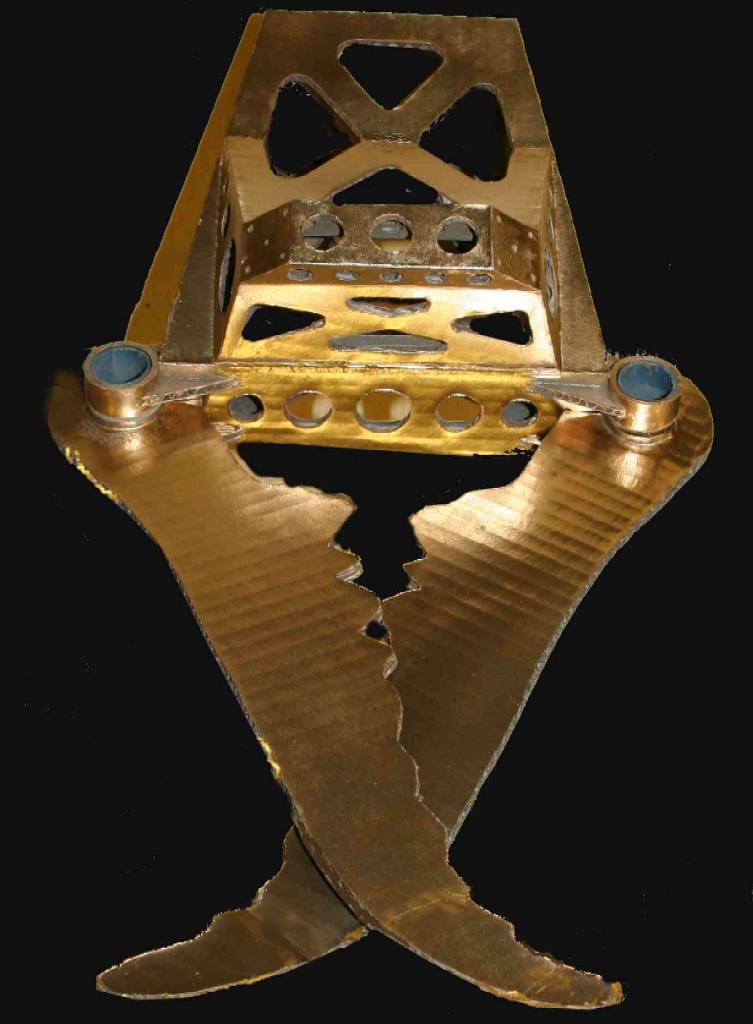|
GOLD
|
||||||||||||||||||||||||||||||||||||||||||||||||||||||||||||||||||||||||||||||||||||||||||||||||||||||||||||||||||||||||||||||||||||||||||||||||||
|
Fort Knox - US gold reserves
Gold is a chemical element in the periodic table that has the symbol Au (L. aurum) and atomic number 79. A soft, shiny, yellow, dense, malleable, ductile (trivalent and univalent) transition metal, gold does not react with most chemicals but is attacked by chlorine, fluorine and aqua regia. The metal occurs as nuggets or grains in rocks and in alluvial deposits and is one of the coinage metals.
For millennia, gold has served as money and is also used in jewellery, dentistry, and in electronics. Gold forms the basis for a monetary standard used by the International Monetary Fund (IMF) and the Bank for International Settlements (BIS). Its ISO currency code is XAU. Notable characteristics
Gold is a metallic element with a characteristic yellow color, but can also be black or ruby when finely divided, while colloidal solutions are intensely colored and often purple. These colors are the result of gold's plasmon frequency lying in the visible range, which causes red and yellow light to be reflected, and blue light to be absorbed. Only silver colloids exhibit the same interactions with light, albeit at a shorter frequency, making silver colloids yellow in color.
It is the most malleable and ductile metal known; a single gram can be beaten into a sheet of one square metre, or an ounce into 300 square feet. A soft metal, gold will readily form alloys with many other metals. This can be done to increase its strength, or create several exotic colors, sold for instance in the western United States to the tourist trade as "Black Hills" gold. Adding copper yields a redder metal, iron blue, Silver produces green, aluminium purple, platinum metals white, and natural bismuth together with silver alloys produce black. Native gold contains usually eight to ten per cent silver, but often much more — alloys with a silver content over 20% are called electrum. As the amount of silver increases, the color becomes whiter and the specific gravity lower.
Gold is a good conductor of heat and electricity, and is not affected by air and most reagents. Heat, moisture, oxygen, and most corrosive agents have very little chemical effect on gold, making it well-suited for use in coins and jewelry; conversely, halogens will chemically alter gold, and aqua regia dissolves it.
Common oxidation states of gold include +1 (gold(I) or aurous compounds) and +3 (gold (III) or auric compounds). Gold ions in solution are readily reduced and precipitated out as gold metal by the addition of virtually any other metal as the reducing agent. The added metal is oxidized and dissolves allowing the gold to be displaced from solution and be recovered as a solid precipitate.
Recent research undertaken by Frank Reith of the Australian National University shows that microbes play an important role in the formation of gold deposits, transporting and precipitating gold to form grains and nuggets that collect in alluvial deposits.
Applications
Pure gold is too soft for ordinary use and is hardened by alloying with silver, copper, and other metals. Gold and its many alloys are most often used in jewelry, coinage and as a standard for monetary exchange in many countries. Because of its high electrical conductivity and resistance to corrosion and other desirable combinations of physical and chemical properties, gold also emerged in the late 20th century as an essential industrial metal.
Gold and silver axe, 3rd-2nd millennium BC
History
Gold (Sanskrit jval, Greek χρυσος [khrusos], Latin aurum for "shining dawn", Anglo-Saxon gold, Chinese 金 [jīn],Japanese 金 [kin]) has been known and highly valued since prehistoric times. It may have been the first metal used by humans and was valued for ornamentation and rituals. Egyptian hieroglyphs from as early as 2600 BC describe gold, which king Tushratta of the Mitanni claimed was as "common as dust" in Egypt. Egypt and Nubia had the resources to make them major gold-producing areas for much of history. Gold is also mentioned several times in the Old Testament. The south-east corner of the Black Sea was famed for its gold. Exploitation is said to date from the time of Midas, and this gold was important in the establishment of what is probably the world's earliest coinage in Lydia between 643 and 630 BC.
The European exploration of the Americas was fueled in no small part by reports of the gold ornaments displayed in great profusion by Native American peoples, especially in Central America, Peru, and Colombia.
Gold has long been considered one of the most precious metals, and its value has been used as the standard for many currencies (known as the gold standard) in history. Gold has been used as a symbol for purity, value, royalty, and particularly roles that combine these properties.
Gold in antiquity was relatively easy to obtain geologically; however, 75% of all gold ever produced has been extracted since 1910. It has been estimated that all the gold in the world that has ever been refined would form a single cube 20 m (66 ft) a side.
The primary goal of the alchemists was to produce gold from other substances, such as lead — presumably by the interaction with a mythical substance called the philosopher's stone. Although they never succeeded in this attempt, the alchemists promoted an interest in what can be done with substances, and this laid a foundation for today's chemistry. Their symbol for gold was the circle with a point at its center, which was also the astrological symbol, the Egyptian hieroglyph and the ancient Chinese character for the Sun (now 日).
During the 19th century, gold rushes occurred whenever large gold deposits were discovered, including the California, Colorado, Otago, Australia, Witwatersrand, Black Hills, and Klondike gold rushes.
Because of its historically high value, much of the gold mined throughout history is still in circulation in one form or another.
Gold bars or ingots
Value
Like other precious metals, gold is measured by troy weight and by grams. When it is alloyed with other metals the term carat or karat is used to indicate the amount of gold present, with 24 carats being pure gold and lower ratings proportionally less. The purity of a gold bar can also be expressed as a decimal figure ranging from 0 to 1, known as the millesimal fineness, such as 0.995.
The price of gold is determined on the open market, but a procedure known as the Gold Fixing in London, originating in 1919, provides a twice-daily benchmark figure to the industry.
Historically gold was used to back currency in an economic system known as the gold standard in which one unit of currency was equivalent to a certain weight of gold. As part of this system, governments and central banks attempted to control the price of gold by setting values at which they would exchange it for currency. For a long period the United States government set the price of gold at $20.67 per troy ounce ($664.56/kg) but in 1934 the price of gold was set at $35.00 per troy ounce ($1125.27/kg). By 1961 it was becoming hard to maintain this price, and a pool of US and European banks began to act together to defend the price against market forces.
On March 17, 1968, economic circumstances caused the collapse of the gold pool, and a two-tiered pricing scheme was established whereby gold was still used to settle international accounts at the old $35.00 per troy ounce ($1.13/g) but the price of gold on the private market was allowed to fluctuate; this two-tiered pricing system was abandoned in 1975 when the price of gold was left to find its free-market level. Central banks still hold historical gold reserves as a reserve asset although the level has generally been declining. The largest gold depository in the world is that of the U.S. Federal Reserve Bank, in New York.
Since 1968 the price of gold on the open market has ranged widely, with a record high of $850/oz ($27,300/kg) on 21 January 1980, to a low of $252.90/oz ($8,131/kg) on 21 June 1999 (London Fixing). Prices have risen to the $500/oz mark in late 2005, due to a depreciation of the US dollar and inflation due to rising energy costs.In January 2006 the goldprice rose above $555/oz and many observers think that fears of a nose-diving dollar will send the price of gold even much higher.
Gold and the money supply
In January 1959 US M3 money supply was $288.8 billion, and the Official Gold Holdings of the United States was then 17,335.1 Tonnes, or about 557 million ounces (there are 32,150.7 Troy Ounces in a Tonne). That means that in 1959, there were $518 in circulation for every ounce of gold reserves held by the USA. Although the theoretical price should then have been $518 per ounce, the actual price, as fixed under the gold standard was only $35 an ounce.
By August 2005, the US M3 money supply had risen to $9,873.9 billion, whilst at the same time the Official Gold Holdings of the United States had fallen to just 8,133.5 Tonnes, or about 261 million Troy Ounces. This means that today, in 2005, there are $37,831 in circulation for every ounce of gold held by the United States. The above numbers show the falling influence of gold in the monetary system of the world today. Goldbugs believe, or even hope, that one day gold's importance will return as the printing of paper money gets out of control and we end in a hyper-inflationary fiat money collapse.
Restrictions on gold ownership
Because of its use as a reserve store of value, the possession of gold is sometimes restricted or banned. Within the United States, the private possession of gold except as jewelry and coin collecting was banned between 1933 and 1975. President Franklin D. Roosevelt expropriated gold by Executive Order 6102, and President Richard Nixon closed the gold window by which foreign countries could exchange American dollars for gold at a fixed rate.
Return of a gold standard?
In the first few years of the 21st century, reports started to circulate that Malaysia was planning a return to the gold standard - to issue and use gold dinars as currency in international trade. The purported purpose of this move would be to reduce dependence on the United States dollar as a reserve currency, and to establish a non-debt-backed currency in accord with Islamic law against the charging of interest. Nonetheless, gold dinar currency has not yet emerged. Privately issued digital gold currency attempt to replicate a gold standard.
Gold in investment portfolios
As a tangible investment gold is sometimes held as part of a portfolio because over the long term gold has an extensive history of maintaining its value. It has in the last century gained ground in relation to fiat currencies owing to inflation. Gold becomes particularly desirable in times of extremely weak confidence and during hyperinflation because gold maintains its value even as fiat money becomes worthless. People who enjoy investing in gold are known as goldbugs.
Futures contracts based on gold currently trade on various exchanges around the world. In the US this occurs primarily on COMEX (Commodity Exchange) which is a subsidiary of the New York Mercantile Exchange. Speculation about the future price of gold and other commodities is carried on at COMEX. Recently, gold-based ETFs like GLD have emerged as a more convenient investment vehicle.
In some countries such as Switzerland, it is possible to hold physical gold as part of an investment portfolio, due to the absence of taxes and narrow bid-ask spreads, however in other countries portfolio managers sometimes hold gold shares or gold bullion securities as a proxy for the metal itself. Exchange Traded Funds such as Gold Bullion Securities are securities sponsored by the World Gold Council and which are fully backed up by allocated gold held by a custodian. The main Gold Bullion Securities are as follows:
Gold nuggets California (top) Australia (bottom) showing octahedral formations
Occurrence
Due to its relative chemical inertness gold is usually found as the native metal or alloy. Occasionally large accumulations of native gold (also known as nuggets) occur but usually gold occurs as minute grains. These grains occur between mineral grain boundries or as inclusions within minerals. Common gold associations are quartz often as veins and sulfide minerals. The most common sulfide associations are pyrite, chalcopyrite, galena, sphalerite, arsenopyrite, stibnite and pyrrhotite. Rarer mineral associations are petzite, calaverite, sylvanite, muthmannite, nagyagite and krennerite.
Gold is widely distributed in the Earth's crust at a background level of 0.03 g/1000 kg (0.03 ppm by weight). Hydrothermal ore deposits of gold occur in metamorphic rocks and igneous rocks; alluvial deposits and placer deposits originate from these sources.
The primary source of gold is usually igneous rocks or surface concentrations. A deposit usually needs some form of secondary enrichment to form an economically viable ore deposit: either chemical or physical processes like erosion or solution or more generally metamorphism, which concentrates the gold in sulfide minerals or quartz. There are several primary deposit types, common ones are termed reef or vein. Primary deposits can be weathered and eroded, with most of the gold being transported into stream beds where it congregates with other heavy minerals to form placer deposits. In all these deposits the gold is in its native form. Another important ore type is in sedimentary black shale and limestone deposits containing finely disseminated gold and other platinum group metals.
Gold occurs in sea water at 0.1 to 2 mg/t (0.1 to 2 ppb by weight) depending on sample location.
Production
Economic gold extraction can be achieved from ore grades as little as 0.5 g/1000 kg (0.5 ppm) on average in large easily mined deposits, typical ore grades in open-pit mines are 1–5 g/1000 kg (1-5 ppm), ore grades in underground or hard rock mines are usually at least 3 g/1000 kg (3 ppm) on average. Ore grades of 30 g/1000 kg (30 ppm) are usually needed before gold is visible to the naked eye, therefore in most gold mines you will not see any gold. It is claimed, that all the gold that has been mined throughout the history of mankind could be incorporated in a solid ball with a diameter of 27 metres.
Since the 1880s South Africa has been the source for a large proportion of the world's gold supply. Production in 1970 accounted for 79% of the world supply, producing about 1,000 tonnes, however production in 2004 was 342 tonnes. This decline was due to the increasing difficulty of extraction and changing economic factors affecting the industry in South Africa.
The city of Johannesburg was built atop the world's greatest gold finds. Gold fields in the Orange Free State and the Transvaal are deep and require the world's deepest mines. The Second Boer War of 1899–1901 between the British Empire and the white Boers was at least partly over the rights of miners and possession of the gold wealth in South Africa.
Other major producers are Canada, United States and Western Australia. Mines in South Dakota and Nevada supply two-thirds of gold used in the United States. Siberian regions of the USSR also used to be significant in the global gold mining industry. Kolar Gold Fields in India is another example of a city being built on the greatest gold deposits in India. In South America, the controversial project Pascua Lama aims at exploitation of rich fields in the high mountains of Atacama, at the border between Chile and Argentina.
The idea of producing gold out of lesser metals or other cheap substances has fascinated people throughout the centuries. Scientists, kings and charlatans obsessed with the secret art of alchemy accidentally invented practically useful materials (e.g. porcelain), while searching in vain for the philosopher's stone, which was supposed to turn mercury into gold. Modern science has since proven the impossibility of making gold from other elements via chemical reactions.
However, it is possible to obtain infinitesimally small amounts of gold by artificial nuclear transformations in particle accelerators The gold isotopes produced would likely be radioactive. No economically feasible method to manufacture gold artificially has been found and published yet. The possibility of cheap man-made gold would have unforeseen economic and consequences.
The world's oceans hold a vast amount of gold, but in very low concentrations (perhaps 1-2 parts per billion). Fritz Haber (the German inventor of the Haber process) attempted commercial extraction of gold from sea water in an effort to help pay Germany's reparations following the First World War. Unfortunately, his assessment of the concentration of gold in sea water was unduly high, probably due to sample contamination. The effort produced little gold and cost the German government far more than the commercial value of the gold recovered. No commercially viable mechanism for performing gold extraction from sea water has yet been identified.
They never found Blackbeard's hidden treasure, but now they have a map and have hired John Storm's boat to get then to the Island, through a raging war.
Compounds/isotopes
Although gold is a noble metal, it can form many compounds, auric chloride (AuCl3) and chlorauric acid (HAuCl4) being the most common. Gold compounds can be aurous (univalent, +1) or auric (trivalent, +3). Gold also can under extreme conditions form a +5 state with fluorine (gold pentafluoride, AuF5), as well as (unusually for a metal), a -1 state. Such compounds containing the Au- anion are called aurides and include caesium auride, CsAu, rubidium auride, RbAu, and tetramethylammonium auride, (CH3)4N+ Au-. Gold also forms:
There is only one stable isotope of gold, and 18 radioisotopes with Au-195 being the most stable with a half-life of 186 days.
Precautions
The human body doesn't absorb gold very well, thus compounds of gold are not normally very toxic. Liver and kidney damage has, however, been reported for up to 50% of arthritis patients treated with gold-containing drugs. Gold used in dentistry is widely regarded as the safest form of restorative material, as well as the most successful.
Symbolism
Gold has been associated with the extremities of utmost evil and great sanctity throughout history. The Golden Calf is a widely-recognised symbol of idolatry and revolt against God. In Communist propaganda, the golden pocket watch and its fastening golden chain were the characteristic accessories of the class enemy, the bourgeois and the industrial tycoons. American Indians of the Sioux tribe called it "The yellow metal that makes the white man crazy"
On the other hand, eminent orators such as John Chrysostom were said to have a mouth of gold with a silver tongue. Gold is associated with notable anniversaries, particularly in a 50 year cycle, such as a golden wedding anniversary, golden jubilee, etc.
Great human achievements are frequently rewarded with gold, in the form of medals and decorations. Winners of races and prizes are usually awarded the gold medal (such as the Olympic Games and the Nobel Prize), while many award statues are depicted in gold (such as the Academy Awards, the Emmy Awards and the British Academy Film Awards).
Medieval kings were inaugurated under the signs of sacred oil and a golden crown, the latter symbolizing the eternal shining light of heaven and thus a Christian king's divinely inspired authority. Wedding rings are traditionally made of gold; since it is long-lasting and unaffected by the passage of time, it is considered a suitable material for everyday wear as well as a metaphor for the relationship. In Orthodox Christianity, the wedded couple is adorned with a golden crown during the ceremony, an amalgamation of symbolic rites.
The symbolic value of gold varies wildly around the world, even within geographic regions. For example, gold is quite common in Turkey but considered a most valuable gift in Sicily.
A Golden Skull - actually the head of a robot prototype by Insectronics to be used for special effects in a sci-fi film in the pre-production stage
LINKS and REFERENCE
WEDDING RINGS
A wedding band, or wedding ring consists of a precious metal ring, usually worn on the base of the ring finger - the fourth finger (with the thumb counted as the first finger). Such a ring symbolises marriage: a spouse wears it to indicate a marital commitment to fidelity. The European custom of wearing such a ring has spread widely beyond Europe. Traditional customsPre-wedding customs
According to some customs, the wedding ring forms the last in a series of gifts which also may include the engagement ring, traditionally given as a betrothal present, and the promise ring, often given when serious courting begins. (Other (more recent) traditions (and the jewelry trade) seek to expand the idea of a series of ring-gifts with an eternity ring, which symbolises the renewal or ongoing nature of a lasting marriage, sometimes given after the birth of a first child, and a trilogy ring (usually) dsplaying three brilliant cut round diamonds each, in turn, representing the past, present and future of a relationship.)
An European tradition encourages the engraving of the name of one's intended spouse and the date of one's intended marriage on the inside surface of wedding rings, thus strengthening the symbolism and sentimentality of the rings as they become family heirlooms.
Wedding ceremony customs
The best man has a traditional duty to keep track of a marrying couple's wedding ring(s) and to produce them at the symbolic moment of the giving and receiving of the ring(s) during the traditional marriage ceremony.
In more grandiose weddings, a ring bearer (usually a young boy) may assist in the ceremonial of parading the ring(s) into the ceremony, often on a special cushion or pillow(s).
Post-wedding customs
Before medical science discovered how the circulatory system functioned, people believed that a vein of blood ran directly from the fourth finger on the left hand to the heart. (This belief allegedly dates to the 3rd century BC in Greece.) Because of the hand-heart connection, people named the putative vein descriptively vena amori, Latin for "the vein of love". Due to this tradition, it became accepted to wear the wedding ring on this finger. By wearing rings on the fourth finger of their left hands, a married couple symbolically declares their eternal love for each other. This has now become a matter of tradition and etiquette.
In most Western cultures, the wedding ring is worn on the left hand. In some countries, however (such as Germany, Norway, and Chile), it is worn on the right hand. Orthodox Christians, East Europeans and Jews also wear the wedding band on the right hand traditionally.
Etiquette frowns severely on the making of sexual overtures to a man or woman wearing a wedding ring.
Contemporary usage
In the United Kingdom and the United States in past generations women wore wedding bands much more commonly than men did. Today, both partners often wear wedding rings, but where occupations or professions forbid or discourage the wearing of jewellery (as in the cases of actors, police and electrical workers) either marriage partner may not wear a ring. In addition, people often remove wedding rings for comfort or safety. So it commonly occurs for chaste married people not to wear a wedding ring. Either partner may wear a wedding ring on a chain around the neck, thus conveying the socially equivalent message to wearing it on a finger.
One interpretation states that the woman wears the wedding ring below the engagement ring, thus making it closer to the heart. Purists hold this practice, though common, as incorrect: they claim no ring should fit above the wedding ring, which should be worn alone.
Materials
Most religious marital ceremonies accept a band of any material (even a rubber band) to symbolise the taking of marriage vows, with unusual substitutions permitted in marriages under unusual circumstances. When people marry on shipboard and cannot obtain or adjust a metal ring of appropriate size, the partners often use rubber bands.
To make wedding rings jewellers most commonly use a precious yellow alloy of gold, hardened with copper, tin and bismuth. Platinum and white alloys of gold class as equivalent or superior to gold. Titanium has recently become a popular material for wedding bands, due to its durability, affordability, and gunmetal grey color. The least expensive material in common use is nickel silver for those who prefer its appearance or cost. Silver, copper, brass and other corroding metals do not occur as frequently because they stain the skin. Marrying couples seldom use stainless steel (which does not count as a precious metal). Aluminum or poisonous metals are almost never used. Rings made by either spouse rank highest; and as a result become so precious to the couple that any material becomes acceptable, even if practically unwearable.
Styles, patterns, fashions
The plain gold band is the most popular pattern. Medical personnel commonly wear it because it can be kept very clean. Woman usually wear narrow bands, while men wear broader bands.
In France and French-speaking countries, a common pattern consists of three interleaved rings. They stand for "faith, hope and love", where love equates to that particular type of perfect love indicated by the ancient Greek word agape. Provocatively, this pattern slides off quickly, because the rings flow over each other.
A traditional Irish wedding ring, the Claddagh ring, has become popular in the United States and Australia as well, thanks to Irish immigration to those countries.
Men in Greek, Italian and Anatolian cultures sometimes receive and wear puzzle rings -- sets of interlocking metal bands that one must arrange just so in order to form a single ring. Women wryly give them as a test for their mens' chastity. Even when the man masters the puzzle, he still cannot remove and replace the ring quickly! In North America, many married women wear two rings on the same finger: an engagement ring and a plain wedding band. Couples often purchase such rings as a pair of bands designed to fit together.
Quote
"With this ring I thee wed." - from the traditional Church of England marriage-ceremony formula.
MONEY FINDER
|
||||||||||||||||||||||||||||||||||||||||||||||||||||||||||||||||||||||||||||||||||||||||||||||||||||||||||||||||||||||||||||||||||||||||||||||||||
|
This website is copyright © 1991- 2022 Electrick Publications. All rights reserved. The bird logo and names Solar Navigator and Blueplanet Ecostar are trademarks ™. The Blueplanet vehicle configuration is registered ®. All other trademarks hereby acknowledged and please note that this project should not be confused with the Australian: 'World Solar Challenge'™which is a superb road vehicle endurance race from Darwin to Adelaide. Max Energy Limited is an educational charity working hard to promote world peace.
|
||||||||||||||||||||||||||||||||||||||||||||||||||||||||||||||||||||||||||||||||||||||||||||||||||||||||||||||||||||||||||||||||||||||||||||||||||
